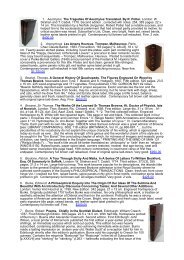Layout A - Royoung Bookseller
Layout A - Royoung Bookseller
Layout A - Royoung Bookseller
You also want an ePaper? Increase the reach of your titles
YUMPU automatically turns print PDFs into web optimized ePapers that Google loves.
24<br />
Samuel Gedge Ltd<br />
ACCOUNT BOOK OF A PROVINCIAL DENTIST<br />
25. [DENTISTRY.] [The account book of dentist William Fothergill of Northgate,<br />
Darlington.]<br />
[Darlington, 1841-1847.] Account book, manuscript, ink on paper. 4to (18.5 x 22.5cm) [86] full pages of accounts,<br />
with additional blanks and a few pages of unrelated notes, paper watermarked “W Kent 1822”, very good in original<br />
leather-backed marbled boards, rebacked, spine titled in gilt; together with small business card (3.8 x 7.6cm) “Wm.<br />
Fothergill, Dentist, Northgate, Darlington”.<br />
A rare and relatively early record of British dentisty, this account book provides detailed information on<br />
the practice of the dentist William Fothergill of Northgate, Darlington between the years 1841 and 1847.<br />
The dental profession in Britain in the first half of the nineteenth century was still in an unorganised state<br />
and it was only during the 1840s that the first steps towards professionalisation were being taken. The first<br />
British dental school was not opened until 1859. William Fothergill, son of Quaker doctor and philanthropist<br />
Dr John Fothergill (1785-1858) was unrepresentative of the dentists of his day on account of his good<br />
education and family medical background. Even serious practitioners in general did not communicate with<br />
each other and guarded their methods jealously. William Fothergill’s brother, Alexander, also worked as<br />
a dentist in Darlington. Reviewing the changes in English dentistry between 1841 and 1891, Alexander<br />
Fothergill would comment on the professional isolation they experienced in the 1840s (see: N.David<br />
Richards. Dentistry in England in the 1840s: the first indications of a movement towards professionalization;<br />
in: Medical History, 1968, April, 12(2), p. 148).<br />
The account book begins in 1841 which appears to be the very start of Fothergill’s dental practice. Wellorganised<br />
in his record-keeping, he has listed dates of appointments, names and occasionally addresses of<br />
patients together with the treatments they received and the costs of procedures such as “stopping”, “filing”,<br />
“extraction” and the preparation of various “models”. In some instances indication is given of the particular<br />
teeth that he was working on. Customers evidently would purchase “tooth powder” and “brushes”<br />
from Fothergill, and there are some records of Fothergill’s own purchasing of supplies with costs, including<br />
“pliers”, “napkins”, “advertising” and “quick silver”. The number of dentists operating in this relatively<br />
modern way in the 1840s was small and few records of this type have survived, making this a valuable<br />
source of information on British dentistry during this period of transition.<br />
£2750




